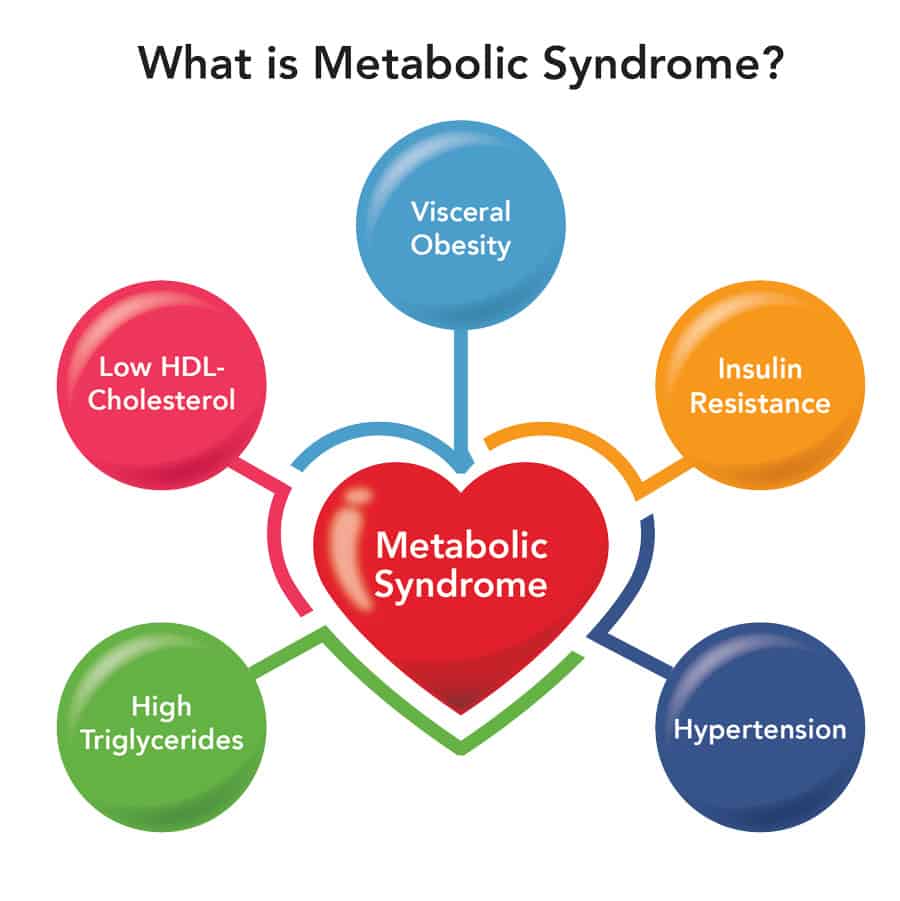Metabolic syndrome is a group of conditions that increase the risk of heart disease, stroke, and Type 2 diabetes. Known also as Syndrome X, Insulin Resistance Syndrome, and Dysmetabolic syndrome, metabolic syndrome can potentially lead to complications such as atherosclerosis, organ damage, and other health issues. The good news is that metabolic syndrome can be cured through lifestyle modifications and medication.
Diagnosing Metabolic Syndrome

To be diagnosed with metabolic syndrome, an individual must exhibit three or more of the following conditions:
- Central Obesity: This refers to carrying excess fat around the waist, often measured by waist circumference. In men, a waist circumference of 40 inches or more, and in women, 35 inches or more, is considered indicative of central obesity.
- High Blood Pressure (Hypertension): Blood pressure is considered high when consistently elevated readings are above 130/85 mm Hg.
- High Blood Sugar (Hyperglycaemia): Elevated fasting blood sugar levels, typically defined as a fasting glucose level of 100 mg/dL or higher.
- High Triglycerides: Triglycerides are a type of fat in the blood. Elevated levels, usually defined as 150 mg/dL or higher, are associated with metabolic syndrome.
- Low HDL Cholesterol: High-density lipoprotein (HDL) cholesterol is often called “good” cholesterol because it helps remove excess cholesterol from the blood vessels. Low levels of HDL, usually below 40 mg/dL for men and below 50 mg/dL for women, are associated with metabolic syndrome.
Each of these conditions alone makes you more prone to developing cardiovascular diseases, Type 2 diabetes, and stroke. However, the presence of three or more increases this risk substantially. Viewing a metabolic syndrome diagnosis should prompt efforts to improve one’s health and reduce these risks. For instance, while high blood pressure alone raises the risk for heart disease, its combination with elevated blood sugar and abdominal obesity further magnifies the chance of developing metabolic syndrome.
How Common is Metabolic Syndrome?
According to reports between 20% and 30% of the adult population in most countries have metabolic syndrome. In fact, metabolic syndrome accounts for an increasing proportion of cardiovascular risk worldwide. In India, the prevalence of the condition is approximately 30% of the population.
Symptoms of Metabolic Syndrome
Many aspects of metabolic syndrome might not manifest as clear symptoms. Hence, the symptoms a person experiences will depend on which of the five conditions they possess. High triglycerides, elevated blood pressure, and reduced HDL cholesterol typically remain asymptomatic. Common symptoms of the various conditions that make up metabolic syndrome are:
- High Blood Pressure (Hypertension): Symptoms of high blood pressure may include headaches, dizziness, shortness of breath, and nosebleeds. However, many people with high blood pressure do not experience noticeable symptoms, which is why it’s often called the “silent killer.”
- High Blood Sugar (Hyperglycaemia): Elevated blood sugar levels may cause symptoms such as Skin darkening in areas like armpits or neck- acanthosis nigricans, increased thirst, frequent urination, fatigue, and blurred vision. However, these symptoms may not be specific to metabolic syndrome and can occur in various other conditions, including diabetes.
- High Triglycerides and Low HDL Cholesterol: Elevated triglycerides and low HDL cholesterol typically do not cause noticeable symptoms on their own. Instead, their effects are more long-term and are assessed through blood tests.
- Central Obesity: While central obesity itself is a criterion for metabolic syndrome, it can also lead to physical symptoms such as back pain, joint pain, and difficulty with mobility.
It’s important to note that the absence of symptoms does not mean that metabolic syndrome is not present. Many individuals with metabolic syndrome may be asymptomatic or have only subtle symptoms. Consult with your doctor or any healthcare professional is advised if you notice these symptoms.
Causes of Metabolic Syndrome
Metabolic syndrome arises from a complex blend of factors, with insulin resistance believed to be the primary culprit. This resistance occurs when the cells in muscles, fat, and liver don’t effectively react to insulin, a hormone crucial for life and blood sugar regulation. Multiple factors can cause these cells to absorb or store glucose, resulting in insulin resistance inefficiently. Consequently, the pancreas produces extra insulin, a condition termed hyperinsulinemia.
Should the body fail to generate adequate insulin to manage blood sugar effectively, it can result in elevated blood sugar levels, potentially leading to prediabetes or Type 2 diabetes. Both insulin resistance and hyperinsulinemia can further cause:
- Obesity
- Heart disease
- Fatty liver disease
- Polycystic ovary syndrome (PCOS)
Factors Leading to Insulin Resistance
Several elements can result in reduced insulin sensitivity-
1. Genetic Factors
Your inherited genes can predispose you to insulin resistance and conditions like obesity, elevated blood pressure, and high cholesterol levels.
2. Central Obesity
Fat stored around your belly or obesity can produce chemicals (known as proinflammatory cytokines) that interfere with insulin’s effectiveness. Central obesity, especially, heightens the risk of insulin resistance. Both visceral fat (around your organs) and subcutaneous fat (beneath the skin) contribute to metabolic syndrome.
3. Inactive Lifestyle
Physical movement makes your muscles increases glucose consumption and uses up your stored glucose or glycogen. This helps increase insulin sensitivity. Conversely, a sedentary lifestyle promotes insulin resistance.
4. Medications
Some drugs, such as corticosteroids, specific blood pressure treatments, certain HIV medications, and some psychiatric drugs, can induce insulin resistance.
Tests for Metabolic Syndrome
Should a healthcare professional suspect metabolic syndrome, they’ll conduct a physical assessment and order blood work. This includes checking blood pressure and potentially measuring waist circumference. Key blood tests can comprise:
Lipid Panel Assessment: Includes cholesterol measurements and triglycerides level.
Basic Metabolic Panel (BMP): Evaluates eight blood components for an overall health brief.
Fasting Blood Sugar Test: If the BMP isn’t conducted in a fasted state, a separate fasting glucose test might be prescribed.
A metabolic syndrome diagnosis is confirmed if three out of the five established criteria are met after these tests’ evaluations. Such tests can include a combination of physical measurements (such as waist circumference and blood pressure) and blood tests (to assess glucose, triglycerides, and HDL cholesterol levels). Healthcare professionals use these measurements and criteria to determine whether a person meets the criteria for metabolic syndrome. If you have concerns about your risk for metabolic syndrome or related health conditions. it’s advisable to consult with a healthcare provider for a comprehensive evaluation and personalized guidance on managing your risk factors.
Metabolic Syndrome Management
Treatment’s primary focus is to lessen the risk of cardiovascular diseases and Type 2 diabetes. Interventions may include medications and lifestyle modifications.
Effective Lifestyle Changes Include-
1. Regular Physical Activity
Exercise provides many benefits – from curbing insulin resistance to promoting heart health. Before initiating any exercise regime, consult a healthcare expert.
2. Stress Management
Prolonged elevated cortisol levels can spike blood sugar, blood pressure, and triglycerides. Implementing stress-relief methods, such as breathing exercises, yoga or mindfulness, can be beneficial.
3. Weight Management
Shedding around 7% of excess weight can prevent Type 2 diabetes risk by 58%, as one study highlighted.
4. Nutritious Diet
Limiting unhealthy fats, sugars, and processed foods and consuming more vegetables, fruits, whole grains, fish, and lean poultry is advisable. The Mediterranean diet serves as a prime heart-healthy example.
5. Prioritizing Sleep
Adequate sleep is crucial. Sleeping disorders like sleep apnea can worsen or even lead to metabolic syndrome. Seek medical advice if sleep issues persist.
6. Quitting Tobacco
Smoking can reduce HDL cholesterol and elevate blood pressure. Quitting is recommended to prevent vascular damage.
Treatments and Medications for Metabolic Syndrome
Medications
There are several medications and treatments to manage the underlying conditions of metabolic syndrome.
- Oral Diabetes meds- most common being metformin, a biguanide
- Blood pressure meds or antihypertensives like thiazide, ACE inhibitors, and calcium channel blockers
- Cholesterol-reducing medications- Statins, also known as HMG CoA reductase inhibitors, are prescribed to normalize cholesterol levels
Weight Loss Surgeries
Bariatric surgery, designed for substantial weight loss in obese individuals, might be recommended when traditional methods fail and when the health risks of obesity surpass surgical risks.
Sleep Disorder Remedies
Treatments for sleep disturbances include devices like CPAP machine for sleep apnea or sleeping pills for insomnia.
Psychotherapy
Psychotherapy also called talk therapy encompasses various techniques to identify and modify detrimental emotions, thoughts, and actions. It might assist in stress management or understanding and altering adverse eating habits.
Ways to Prevent this condition
While certain contributing factors to metabolic syndrome, such as age and genetics, are unchangeable, one can still prevent its onset. The preventive steps reflect those of the treatment strategies. For individuals with a genetic predisposition towards diabetes, hypertension, or elevated cholesterol, informing a healthcare professional is essential. Regular health check-ups are invaluable for early detection and intervention.
Potential Complications
Metabolic syndrome can lead to several additional health issues:
- Stroke.
- Aortic stenosis.
- Atrial fibrillation (Afib).
- Cognitive and memory issues.
- Venous Thromboembolism and Thromboembolic disease.
- Organ impairment, with organs like the pancreas, liver, gallbladder, and kidneys being vulnerable.
- Certain cancers such as those of the colon, breast, and prostate cancers.
- Chronic inflammation and immune system dysfunctions.
- Male impotence- erectile dysfunction.
- Pregnancy complications like preeclampsia, eclampsia, and gestational diabetes.
How to Live and Manage Metabolic Syndrome
For those diagnosed with metabolic syndrome, continuous medical supervision is crucial. Regular consultations with healthcare providers for monitoring your condition, addressing treatment concerns, or inquiries about lifestyle modifications are essential.
Take Away
Metabolic syndrome raises your chances of developing cardiovascular diseases, diabetes, stroke, and disorders caused by arterial fat deposits (atherosclerosis). The syndrome’s root causes include obesity, insulin resistance, sedentary lifestyles, hereditary factors, and aging.
Despite the gravity of the condition, risks can managed by weight reduction, increased physical activities, adopting a diet rich in whole grains, fruits, vegetables, and fish, and consistent health monitoring. So, put in the effort to lead a healthy lifestyle to avoid this serious condition.
Can Metabolic Syndrome Be Reversed?
Certainly, metabolic syndrome is reversible. The silver lining is the potential reversibility of metabolic syndrome through timely interventions. Both lifestyle adaptations and medications can significantly improve health conditions. Personalized care plans are developed with the help of healthcare professionals.
Ensocure Integrated Medicine provides several services such as nutritionists, weight management, diabetes care and general healthcare perfectly meeting the criteria to help reverse metabolic syndrome.

